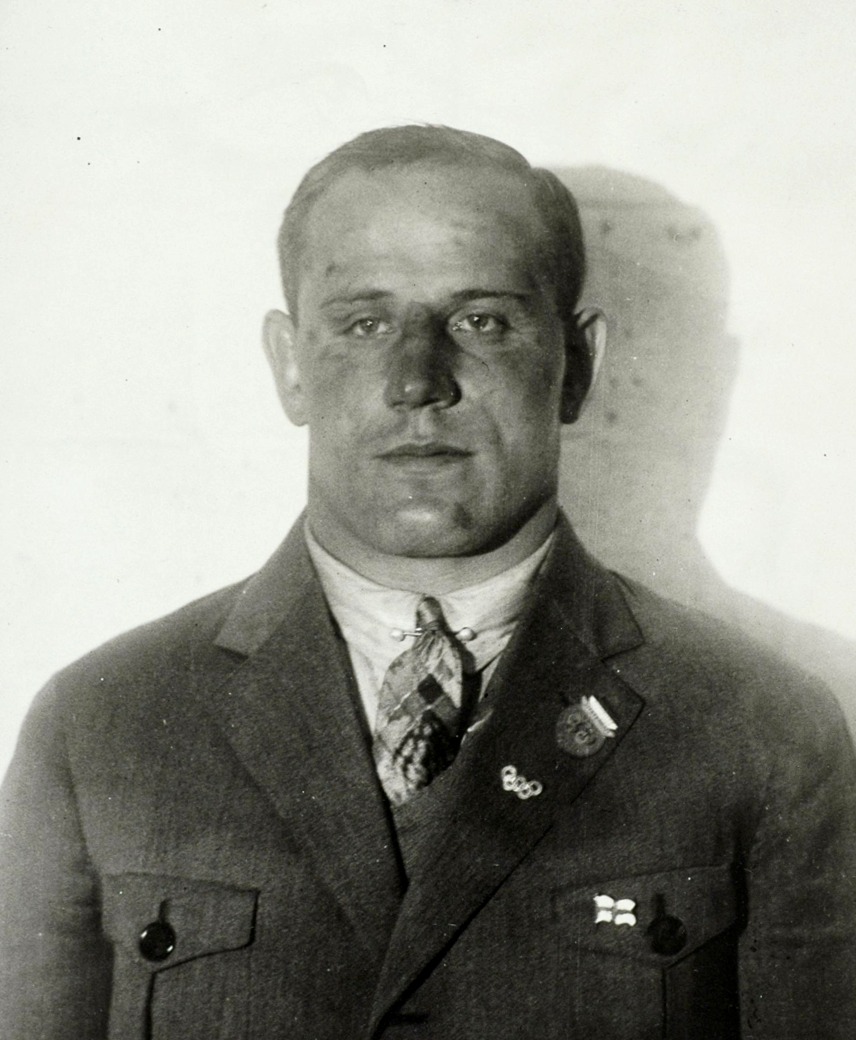1. Overview
Väinö Kokkinen (Väinö KokkinenFinnish, 1899-1967) was a distinguished Finnish Greco-Roman wrestler and a significant figure in Finnish sports history. Born a blacksmith, Kokkinen participated in the Finnish Civil War before embarking on a highly successful wrestling career. He notably secured two Olympic gold medals in the middleweight category at the 1928 Amsterdam and 1932 Los Angeles Olympic Games. Beyond his Olympic successes, he earned multiple medals at European championships and dominated the Finnish national wrestling scene with six titles. After retiring from competitive wrestling in 1936, Kokkinen transitioned into successful business ventures in the clothing and hospitality sectors and contributed to sports administration, serving on the board of the sports club Helsingin Jyry. His journey from humble beginnings to international athletic fame and subsequent entrepreneurial success exemplifies his enduring legacy in Finnish society and sports.
2. Early Life
Väinö Kokkinen's early life was marked by his birth into a Finnish family and his profession as a blacksmith, an occupation that spoke to his working-class roots. He also played a part in a pivotal moment in Finnish history, the Finnish Civil War.
2.1. Birth and Upbringing
Väinö Kokkinen was born on November 25, 1899, in Hollola, which was then part of the Grand Duchy of Finland, within the Russian Empire. Little is detailed about his immediate family or the specific environment of his childhood, but his later profession suggests a background rooted in manual labor.
2.2. Early Career and Finnish Civil War Participation
Before he became a prominent wrestler, Kokkinen worked as a blacksmith, a physically demanding trade that likely contributed to his formidable strength and endurance. His early life also coincided with a turbulent period in Finnish history, and he participated in the Finnish Civil War. This conflict, which occurred in 1918, profoundly shaped the young nation and its citizens, including Kokkinen.
3. Wrestling Career
Väinö Kokkinen's wrestling career, which commenced in 1921, was characterized by remarkable achievements on both the national and international stages, culminating in multiple Olympic and European medals. Standing at 68 in (172 cm) and competing in the 172 lb (78 kg) to 187 lb (85 kg) range, he was a formidable opponent.
3.1. Career Start
Kokkinen began his wrestling journey in 1921. This decision followed his relocation to Helsinki, the capital city of Finland, where he immersed himself in wrestling training. His dedication quickly propelled him into the competitive wrestling circuit.
3.2. Olympic Achievements
Kokkinen achieved his most significant successes at the Olympic Games, where he became a two-time gold medalist.

At the 1928 Summer Olympics held in Amsterdam, he won his first gold medal in the middleweight category, specifically the 75 kg event. Four years later, at the 1932 Summer Olympics in Los Angeles, he again claimed the gold medal, this time in the 79 kg middleweight division, solidifying his status as an Olympic champion. Kokkinen also competed in the 1936 Summer Olympics, where he finished in a respectable fourth place, marking his final Olympic appearance before retiring from competitive wrestling.
3.3. European and National Championship Achievements
Beyond his Olympic triumphs, Väinö Kokkinen amassed a significant collection of medals at the European Wrestling Championships and dominated the national wrestling scene in Finland.
Between 1925 and 1933, he earned a total of five medals at the European Championships. He secured one gold medal at the 1930 European Championships in Stockholm, competing in the 79 kg category. His four silver medals were won at various championships: in 1925 in Milan (79 kg), in 1929 in Dortmund (79 kg), in 1931 in Prague (79 kg), and in 1933 in Helsinki (87 kg).
Domestically, Kokkinen was a dominant force, securing six national titles in Finland. These national championships were won in 1926, and consecutively from 1929 to 1932, with his final national title secured in 1934.
4. Post-Retirement Activities
Upon retiring from his distinguished wrestling career in 1936, Väinö Kokkinen channeled his drive and determination into successful professional and administrative endeavors, transitioning from athletic competition to the world of business and sports governance.
4.1. Business Activities
After stepping away from competitive wrestling, Kokkinen proved to be an astute businessman. He established and managed successful ventures within the clothing and hospitality industries. These entrepreneurial pursuits demonstrated his ability to excel outside the wrestling arena and contributed to his financial success.
4.2. Sports Administration Activities
Kokkinen also remained connected to the world of sports through administrative roles. During the 1940s, he dedicated his time and expertise as a board member of the sports club Helsingin Jyry. This role allowed him to contribute to the organizational and developmental aspects of Finnish sports, further solidifying his legacy beyond his competitive achievements.
5. Death
Väinö Kokkinen died on August 27, 1967, at the age of 67. His passing occurred in Kouvola, Finland.
6. Legacy and Assessment
Väinö Kokkinen's legacy is deeply etched in the annals of Finnish sports, particularly in the discipline of Greco-Roman wrestling. As a two-time Olympic gold medalist and a multiple European and national champion, he is remembered as one of Finland's most successful wrestlers of his era. His achievements brought significant international recognition to Finnish athletics. Beyond his competitive success, his transition from a blacksmith and Civil War participant to an Olympic champion and then a successful entrepreneur and sports administrator paints a picture of a resilient and multifaceted individual. Kokkinen's life trajectory, from humble beginnings to international acclaim and continued contribution to society, underscores his importance as an enduring symbol of Finnish athletic prowess and national pride.